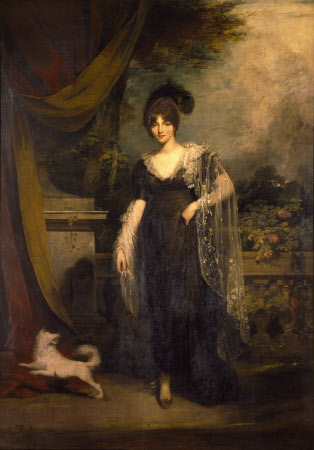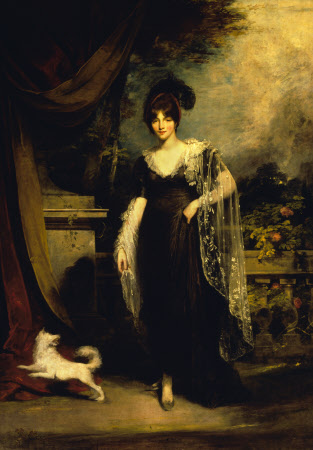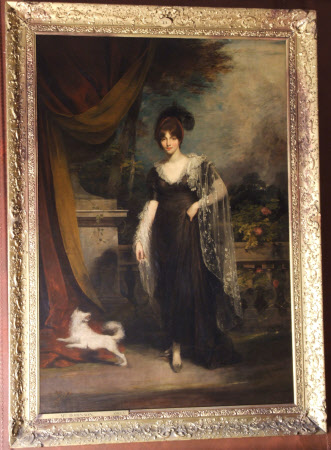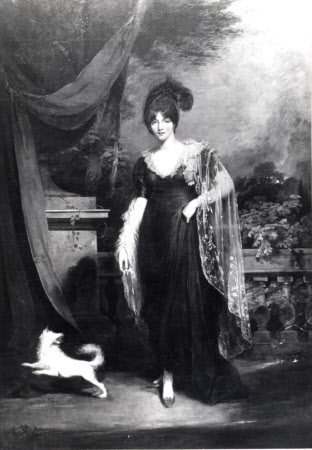Called Mary Darby, Mrs Thomas Robinson, known as ‘Perdita’ (1758 - 1800)
William Owen, RA (Ludlow 1769 – London 1825)
Category
Art / Oil paintings
Date
circa 1792 - 1803 (exh RA)
Materials
Oil on canvas
Measurements
2000 x 1750 mm (98½ x 69 in)
Place of origin
England
Order this imageCollection
Petworth House and Park, West Sussex
NT 486132
Caption
Mary Darby, Mrs Thomas Robinson, was an actress, known as ‘Perdita’. At the age of 18, she appeared in Drury Lane as Juliet in Romeo and Juliet and instantly became famous. She then played Perdita in ‘A Winter’s Tale’, and in 1779 she was taken up by the Prince of Wales (later George IV) and became his mistress. Within three years he had abandoned her, and despite later becoming a famous hostess, writing poems and plays, she died destitute. If this picture does represent Mrs Robinson, it is possible, judging by her age, that it was painted some ten years before it was exhibited at the Royal Academy (1803) (where it was described simply as ‘Mrs Robinson’). It is true that the resemblance between this and the majority of accepted portraits of ‘Perdita’ is slight, but there does exist an engraving which bears similarities with the present portrait. Moreover the stance of the figure in this painting is on the theatrical side.
Summary
Oil painting on canvas, Called Mary Darby, Mrs Thomas Robinson, known as ‘Perdita’ (1758-1800) by William Owen RA (Ludlow 1769 – London 1825), circa 1792/1803. A full-length portrait, standing, full face, on a terrace, with her left arm akimbo wearing a deep brown dress, lace shawl and a black plumed hat; a white lap dog is in the left corner and a deep red and gold curtain is at left.
Full description
William Owen has yet to receive his due as a portrait-painter. His portraits, when one encounters them, are distinctive and have considerable power (a good example of a male portrait is the Sir Thomas Dyke Acland, 1818, at Killerton); what they lack is the ingratiating quality that might, for all its drawbacks, have helped them to the revived fame of those British portrait-painters promoted in America by Duveen. The Redgraves damn him with faint praise , whilst R.E. Graves in the Dictionary of National Biography, though saying that his portraits are "truthful and characteristic", accused them of being "somewhat weak in drawing", and, after giving a list of distinguished male sitters, says that: "His portraits of ladies were not equally successful" (which is contradicted, not only by the present picture, but, for instance, by the Lady Leicester at Tabley Hall). In more recent times, he has been accorded a cool entry, and no illustration, in Robin Simon's The Portrait in Britain and America , but not even a mention in John Wilson's essay (continuing the American neglect of him) on 'The Romantics 1790-1830' in The British Portrait . Yet, in his own day, Owen was not only very successful, earning £3,000 a year in his heyday, but keenly appreciated by such connoisseurs as Sir John Leicester and George IV, who, as Prince of Wales, appointed him his official portrait-painter on the death of Hoppner in 1810, and, as Prince Regent, appointed him principal portrait-painter in 1813. In our own time, the rediscovery and attribution to Owen of the Hon. Henrietta Monckton, Mrs. Robert Pemberton Milnes was one of the sensations of the recent exhibition of Masterpieces from Yorkshire Houses . The portrait of Mrs Robinson has always made a considerable impact even in the crowded hang of the North Gallery at Petworth, where it was hung in a conspicuous position beside Flaxman's Saint Michael . Yet curiously, although the picture was No.1 in the 1803 exhibition of the Royal Academy, and has always been hung in a position of prominence at Petworth, no-one ever seems to have recorded who the sitter was, or why the 3rd Earl of Egremont should have bought or commissioned her portrait. In view of Lord Egremont's reputation - and in particular of Creevey's account of his visit to Petworth in 1828, when he drew the conclusion that one portrait after another was of a former member of "my Lord's Seraglio" -the suspicion inevitably arises that the reason for the presence of Owen's portrait was of the same order. Because of the name, she has often been assumed to be Mary Darby, Mrs. Robinson, the Prince Regent's 'Perdita' (1758 -1800), celebrated by portraits of her by Gainsborough, Romney and Reynolds in the Wallace Collection and at Waddesdon - the more so since Owen came to Reynolds's notice by copying one of his portraits of 'Perdita', and was given encouragement by him. But she had died three years before, at the age of forty-two - and there is nothing posthumous about this portrait, nor any resemblance to those of her. There are three or four Mrs Robinsons that seem potential candidates for the sitter in this portrait. There is a mysterious 'Mrs. Robinson' who appears to have been keeping late hours in appropriately louche company, who is mentioned in a letter of William Eliot (later 2nd Earl of St. Germans) to Lady Harrowby of 21 July 1808 - but since the company was that of the Princess of Wales, she would be unlikely to have given a portrait commission to the Prince's Painter, any more than the Earl of Egremont would have acquired a portrait of a companion of the Princess. More promising is the wife of Sir Christopher Robinson (not knighted until 1809), who was to be, as King's Advocate, one of George IV's advisers in the trial of Queen Caroline in 1820 . Although of modest origins, he became rich as an Admiralty lawyer, and he married in 1799 a rich wife, Catherine (1776/7 -1830), daughter of the Rev. Ralph Nicholson, Rector of Didcot. Of her and her character - other than that she bore him three sons and two daughters - we know nothing, however. Another other candidate who seems worth considering, because she was the sister of a friend of Farington's, who was in turn friendly with Owen, is Miss Waring (d.1817), the wife of a Colonel Robinson (d. c.1815), and eldest sister of Fanny Waring, Farington's friend, who was in 1804 married to the Reverend William Curtis; she lived at Thornbury. This is little enough to go on, but at least the known dates of death of herself and her husband allow of the possibility of the Earl of Egremont buying her portrait at a posthumous sale. Finally, and above all because the naming of sitters in the catalogues of Royal Academy exhibitions was by no means general at this date, unless they had some particular claim to fame or notoriety, it is worth considering the claims of an actress (such as the more celebrated Mrs Robinson, 'Perdita' had also been). The only possible candidate would appear to be Letitia Ann Hoare (fl.1773 -1817), successively known as Mrs Sage -culminating in her most famous exploit, as "The First [English] Female Aerial Traveller" in Lunardi & Biggin's balloon in May 1785 - and Mrs. Robinson - when she reappeared as dresser and wardrobe-keeper for Charles Dibdin, Junior in 1804, after almost twenty years' disappearance from view . That disappearance could have been because she was, as some jealous lover's mistress, kept off the stage; but if she were to have made a return of such éclat as in this portrait - and could the sitter anyway really be as old as in her forties? - would she thereafter have had such a humble role as Dibdin's dresser? But in sad truth, we must conclude with Lord Egremont's answer to Creevey's too persistent questioning about the identity of the sitter in a Reynolds portrait that was being copied during his stay at Petworth: "Oh!" he said, "it was a lady not much known in the world".' Notes: (i) A Century of British Painters, 2nd edn. [1890], 1947, pp.239-40. (ii) Dictionary of National Biography, ed. Sidney Lee, vol. XLII (1895), p.457. (iii) Oxford, 1987, p.214. (iv) The Antique Collectors Club, Woodbridge, 1991. (v) Farington, p.3833, 24/12/1810. (vi) exh. cat. York City Art Gallery, 1994, No.13. (vii) Christopher Rowell, 'The North Gallery at Petworth: An Historic Re-appraisal', Apollo, July 1993, pp.29 -36. (viii) Creevey, ed. John Gore, 1948, pp.291 -92. (ix) The Correspondence of George, Prince of Wales: 1770 -1812, ed. A. Aspinall, vol.VI (1969), p.282, n.2. (x) Sir Edward Parry, Queen Caroline, 1930, pp.259 & 263. (xi) See P.H. Highfill, Jr., K.A. Burnim, & E.A. Langhans, A Biographical Dictionary of Actors, Actresses, &c., vol.13 (1991), pp.167-69. (adapted from author's version/pre-publication, Alastair Laing, In Trust for the Nation, exh. cat., National Gallery, 1995)
Provenance
In the 3rd Earl of Egremont's collection by c.1827 when appeared in a painting by J.M.W. Turner c.1827 of the North Gallery hanging in the north bay over the chimneypiece.; thence by descent, until the death in 1952 of the 3rd Lord Leconfield, who had given Petworth to the National Trust in 1947, and whose nephew and heir, John Wyndham, 6th Lord Leconfield and 1st Lord Egremont (1920-72) arranged for the acceptance of the major portion of the collections at Petworth in lieu of death duties (the first ever such arrangement) in 1956 by HM Treasury
Credit line
Petworth House, The Egremont Collection (acquired in lieu of tax by HM Treasury in 1956 and subsequently transferred to the National Trust)
Makers and roles
William Owen, RA (Ludlow 1769 – London 1825), artist
Exhibition history
In Trust for the Nation, National Gallery, London, 1995 - 1996, no.12



